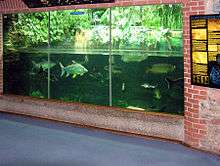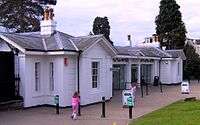Bristol Zoo
 | |
|
Main entrance | |
| Date opened | 1836 |
|---|---|
| Location | Bristol, England |
| Coordinates | 51°27′48″N 2°37′20″W / 51.46333°N 2.62222°WCoordinates: 51°27′48″N 2°37′20″W / 51.46333°N 2.62222°W |
| Land area | 12 acres (5 ha) |
| Number of animals | 7155 (2007)[1] |
| Number of species | 419 (2007) |
| Memberships | The Bristol, Clifton and West of England Zoological Society |
| Major exhibits | Zona Brazil, Seal and Penguin Coasts, Gorilla Island |
| Website |
www |
Bristol Zoo is a zoo in the city of Bristol in South West England. The zoo's stated mission is "Bristol Zoo Gardens maintains and defends biodiversity through breeding endangered species, conserving threatened species and habitats and promoting a wider understanding of the natural world".[2]


The mammal collection at the zoo numbers around 300, representing 50 species, including: okapis, which Bristol was one of the first zoos in the world to breed, Asiatic lions, pygmy hippos, and red pandas. Among species now on view at Bristol which are rare or absent in other UK zoos are Livingstone's fruit bats and successful breeding groups of western lowland gorillas and aye ayes.
The zoo's Twilight Zone was the first of its kind when it opened, there are many other indoor exhibits including an insect and reptile house and aquarium meanwhile outside there are several aviaries and a seal and penguin enclosure. The lakes' islands are home to gorillas, tamarins, marmosets, gibbons and pelicans.
Animal exhibits
- Seal and Penguin Coasts is a major attraction at the zoo; opened in 1999, it allows South American fur seals and African penguins to be watched both above and below the water. The two pools contain 145,000 imperial gallons (660,000 l) of salt water, with waves, waterfalls, rocks and pebble beaches to simulate the natural habitat. The exhibit has a large net over the top to allow Inca terns and common eiders to be kept in the same enclosure.
- Explorers' Creek opened in May 2009 and features three areas – a water play area, a tropical bird house and a walk-through lorikeet feeding area.
- Gorilla Island is home to a family of western lowland gorillas, which are the largest animals kept at Bristol Zoo. As well as an indoor house which is also home to okapis( Sometime before 2016 the okapis were replaced with red river hogs.), they have a large island which they share with the De Brazza's monkeys from Monkey Jungle. The gorillas are herbivores, and are not aggressive. However the keepers do not enter their island home because it is the zoo's policy to keep the animals' captive environment as similar as possible to that of their natural African forest habitat.
- The Terrace is one of the oldest parts of the zoo. It is home to a pair of lions, keas, red pandas, fruit bats and flamingos as well as Twilight World which was the first such exhibit to offer the daytime visitor the chance to view the twilight behaviour of nocturnal animals. By exchanging night and day, the animals (which are awake during their 'night') can be observed during daylight hours. The lights allow a natural transition from night to day and vice versa. Twilight world is split into four zones: the Desert (sand cats, mongooses, rattlesnakes, kangaroo rats and geckos), the Rainforest (slow loris, mouse deer, sloths, owl monkeys, aye-ayes, possums and mouse lemurs), the Cave (scorpions, blind cave fish and naked mole rats) and the House (rats and mice).
- The Reptile House houses a collection of reptiles and amphibians. The house itself is heated and gives a sense of the heat of the rainforest. There are three sections to the house: Desert (Gila monsters, geckos and tortoises), Rainforest (dwarf crocodiles, terrapins and snakes) and the Rearing Room where visitors can view the raising of reptiles and amphibian and also learn about the zoo's conservation work. Outside, but still considered part of the reptile house, is a giant tortoise and rhinoceros iguana enclosure where the animals have access to a heated indoor house and an outdoor enclosure.
- The Aquarium has around 70 species of fish. The aquarium has three sections: The Amazon River (catfish, pacu and piranha), Africa (chiclids) and the coral reef (seahorses, corals and various species of fish). On the outside of the building there is a water sculpture. There are several exhibits of conservation significance on view. Notably, there is a display of endangered cichlids from Lake Barombi Mbo in Cameroon and a display of goodeids from Mexico.

- Bug World, the zoo's collection of invertebrates, includes species such as Partula snails, stick and leaf insects, corals and peacock mantis shrimp. Other displays include tarantulas, black widow spiders, giant millipedes, honey bees, leaf-cutting ants and Lord Howe Island stick insects.
- Zona Brazil includes a tropical house that has Amazon tree boas and tarantulas. The two monkey enclosures house Geoffrey's marmosets, black lion tamarins and titi monkeys. Outside, there are aviaries for red-tailed amazon parrots, an enclosure for golden lion tamarins and three linked paddocks for tapirs and capybaras.
- Monkey Jungle and Monkey Islands opened in 2006 featuring four new exhibits replacing the old monkey house. An enclosure is home to red ruffed lemurs and ring-tailed lemurs where visitors can walk in with the lemurs without any boundaries. The other enclosures are home to lion-tailed macaques, black howlers and De Brazza's monkeys which also have access to Gorilla Island. The islands opposite Gorilla Island house a family of squirrel monkeys, a pair of agile gibbons, saki monkeys and also golden-headed lion tamarins.
- The Butterfly House is made up of an undercover walk-through in a sustainably-heated, climate-controlled polytunnel. . Species on show include the blue morpho butterflies, glasswings, leopard lacewings and atlas moths. The exhibit is linked to butterfly projects run by the zoo in Kenya and Costa Rica. The zoo also supports work to protect the rare silky wave moth in Avon Gorge. Butterfly Forest
History
Opened in 1836 by the Bristol, Clifton and West of England Zoological Society, Bristol Zoo is the world's oldest provincial zoo. It is a Victorian walled zoo located between Clifton Down and Clifton College, near Brunel's Clifton Suspension Bridge; it covers a small area by modern standards, but with a considerable number of species. In the 1960s the zoo came to national prominence by appearing in the UK television series, Animal Magic, hosted by the comic animal 'communicator', Johnny Morris. Morris would play keeper and voice all the animals there.
The zoo's official name is Bristol Zoological Gardens ('Bristol Zoo Gardens' for commercial purposes). This is not in recognition of the flower displays but recognises the first use of that title at the Regent's Park Zoological Gardens. Bristol, like its earlier London counterpart, includes several original buildings which have been praised for their architectural quirks, despite being unsuitable for the care of animals; the (former) Giraffe House[3] joins the main entrance lodge[4] and the south gates on Guthrie Road[5] as a Grade II listed building. The old Monkey Temple, resembling a southern-Asian temple, is now home to an exhibit called "Smarty plants", an interactive exhibit which shows how plants use and manipulate animals to survive.
The zoo also has breeding firsts, including the first black rhino born in Britain in 1958, the first squirrel monkey born in captivity in 1953 and the first chimpanzee born in Europe in 1934.
In December 2014, the zoo lost three of its rarest animals after two fatal incidents, including one involving a male warty pig which killed its own baby. The pig also attacked the baby's mother who had to be put down. In a separate incident a few days later, a South American monkey was also eaten by an otter.[6]
Conservation

Bristol Zoo supports wildlife conservation, education and breeding programmes worldwide. For example, Bristol works with other zoos around the world to breed lemurs in captivity. Native to Madagascar, the lemurs are critically endangered because their forest habitat is being destroyed.
Bristol Zoo supports the UK/US charity Ape Action Africa, which rescues and rehabilitates primates in Cameroon, West Africa.[7]
Closer to home, the zoo has helped to reintroduce the water vole to parts of Southern England.
Wild Place Project
A number of mammals are kept on a site to the north of Bristol and there are plans to relocate many more species to the Hollywood Tower estate near Cribbs Causeway, as part of a second zoo.
The new site is called the Wild Place Project, and is designed to house larger animals than the existing Bristol Zoo. The zoo is split into biomes, representing species found only in specific habitats. Current areas include: Secret Congo, native European woodland, Edge of Africa and Madagascar. The species list currently includes: okapi, Sudan cheetah, zebra and Eurasian wolf.
Some of the biomes to be included are: Central American Swamp, Sumatra Tropical Forest, Nepal Riverine Forest, Coral Reef and British Wetlands. The species list for each ecosystem has not yet been finalised, but is likely to include manatees, crocodiles, bonobos, bongo, Sumatran tiger, orangutan, giraffe, zebra, warthog, kudu, African hunting dog, rhinoceros and brown bear.
The site officially opened on 22 July 2013 as Wild Place Project.[8]
Event hosting
The WOMAD music festival came to the zoo in 2011,[9][10][11][12][13][14] with a subsequent event in 2012.[15][16][17]
Gallery
 Seal and Penguin Coasts: the "underwater" tunnel, with South American fur seal
Seal and Penguin Coasts: the "underwater" tunnel, with South American fur seal- Greater flamingo (Phoenicopterus roseus)
 Humour at the zoo
Humour at the zoo- Elephant tower sculpture, based on Wendy who died in 2002
See also
References
- ↑ Bristol Zoo Annual Report 2007 Archived 6 June 2007 at the Wayback Machine.
- ↑ "Bristol Zoological Gardens Strategic Plan 2008-2018". Bristol, Clifton and West of England Zoological Society Limited. Retrieved 5 August 2016.
- ↑ "Bristol Zoological Gardens, Giraffe House". Images of England. Retrieved 18 December 2006.
- ↑ "Bristol Zoological Gardens entrance". Images of England. Retrieved 18 December 2006.
- ↑ "South entrance gates and screen walls to Bristol Zoological Gardens". Images of England. Retrieved 18 December 2006.
- ↑ http://m.bbc.com/news/uk-england-bristol-31172041
- ↑ Bristol Zoo website – Bristol Zoo presents gorilla sculpture to Cameroon school children – 14/04/11 Archived 17 April 2011 at the Wayback Machine.. Bristolzoo.org.uk.
- ↑ New Bristol attraction opens 22 July | The Wild Place Project. Wildplace.org.uk.
- ↑ Bristol Zoo teams up with Womad for summer spectacular – Bristol24-7. Bristol247.com (17 March 2011).
- ↑ AN evening of music from around the world will be staged at Bristol Zoo this summer as it teams up with the WOMAD festival for a unique concert.. This is Bristol (18 March 2011).
- ↑ Bristol Zoo teams up with WOMAD to offer a wild music festival – 17/03/11 | Bristol Zoo
- ↑ Final acts revealed for WOMAD music festival at Bristol Zoo. Visit Bristol.
- ↑ Trio of acts complete line-up for zoo's summer world music event. This is Bristol (24 May 2011).
- ↑ Bristol University | School of Biological Sciences | Womad at Bristol Zoo. Bristol.ac.uk (2 June 2011).
- ↑ WOMAD Festival returns to Bristol Zoo Gardens for another musical extravaganza – Bristol24-7. Bristol247.com (16 March 2012).
- ↑ Music festival returns to the zoo. This is Bristol (9 May 2012).
- ↑ At Bristol Zoo 2012 » Festivals. WOMAD (22 June 2013).
External links
| Wikimedia Commons has media related to Bristol Zoo Gardens. |
